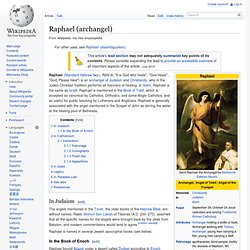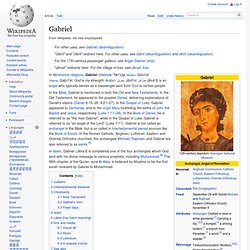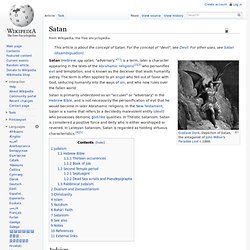

Christian angelic hierarchy. For other angelic hierarchies, see Hierarchy of angels.

Orthodox icon of nine orders of angels. The most influential Christian angelic hierarchy was that put forward by Pseudo-Dionysius the Areopagite in the 4th or 5th century in his book De Coelesti Hierarchia (On the Celestial Hierarchy). During the Middle Ages, many schemes were proposed, some drawing on and expanding on Pseudo-Dionysius, others suggesting completely different classifications. According to medieval Christian theologians, the angels are organized into several orders, or "Angelic Choirs".[1][2] Pseudo-Dionysius (On the Celestial Hierarchy) and Thomas Aquinas (Summa Theologica) drew on passages from the New Testament, specifically Ephesians 1:21 and Colossians 1:16, to develop a schema of three Hierarchies, Spheres or Triads of angels, with each Hierarchy containing three Orders or Choirs. First Sphere[edit] The first sphere angels serve as the heavenly servants of God the Son incarnated.
Seraphim[edit] Cherubim[edit] St. C. Raphael (archangel) Raphael (Standard Hebrew רָפָאֵל, Rāfāʾēl, "It is God who heals", "God Heals", "God, Please Heal") is an archangel of Judaism and Christianity, who in the Judeo-Christian tradition performs all manners of healing.

In Islam, Raphael is the same as Israfil. Raphael is mentioned in the Book of Tobit, which is accepted as canonical by Catholics, Orthodox, and some Anglo-Catholics, and as useful for public teaching by Lutherans and Anglicans. Raphael is generally associated with the angel mentioned in the Gospel of John as stirring the water at the healing pool of Bethesda. The angels mentioned in the Torah, the older books of the Hebrew Bible, are without names. Rabbi Shimon ben Lakish of Tiberias (A.D. 230–270), asserted that all the specific names for the angels were brought back by the Jews from Babylon, and modern commentators would tend to agree.
Raphael is named in several Jewish apocryphal books (see below). Raphael bound Azazel under a desert called Dudael according to Enoch 10:4–6: Gabriel. In Abrahamic religions, Gabriel (Hebrew: גַּבְרִיאֵל, Modern Gavri'el Tiberian Gaḇrîʼēl, God is my strength; Arabic: جبريل, Jibrīl or جبرائيل Jibrāʾīl) is an angel who typically serves as a messenger sent from God to certain people.

In Islam, Gabriel (Jibra'il) is considered one of the four archangels whom God sent with his divine message to various prophets, including Muhammad.[6] The 96th chapter of the Quran, sura Al-Alaq, is believed by Muslims to be the first surah revealed by Gabriel to Muhammad. Watcher (angel) Uriel. Uriel (אוּרִיאֵל "El/God is my light", Auriel/Oriel (God is my light) Standard Hebrew Uriʾel, Tiberian Hebrew ʾÛrîʾēl) is one of the archangels of post-Exilic Rabbinic tradition, and also of certain Christian traditions.

In Judaism and Christianity[edit] Name and origins[edit] Uriel is often identified as a cherub and angel of repentance.[4] He "stands at the Gate of Eden with a fiery sword",[5] or as the angel who "watches over thunder and terror".[6] In the Apocalypse of Peter he appears as the Angel of Repentance, who is graphically represented as being as pitiless as any demon. Demon. In Ancient Near Eastern religions as well as in the Abrahamic traditions, including ancient and medieval Christian demonology, a demon is considered an unclean spirit, sometimes a fallen angel, the spirit of a deceased human, or a spirit of unknown type which may cause demonic possession, calling for an exorcism.

In Western occultism and Renaissance magic, which grew out of an amalgamation of Greco-Roman magic, Jewish demonology and Christian tradition,[2] a demon is a spiritual entity that may be conjured and controlled. Terminology[edit] The Greek term does not have any connotations of evil or malevolence. In fact, εὐδαιμονία eudaimonia, (literally good-spiritedness) means happiness. The supposed existence of demons remains an important concept in many modern religions and occultist traditions. Psychological archetype[edit] M.
By tradition[edit] Ancient Near East[edit] Mesopotamia[edit] Human-headed winged bull, otherwise known as a Lamassu. Satan. Satan (Hebrew: שָּׂטָן satan, "adversary,"[1]) is a term, later a character appearing in the texts of the Abrahamic religions[2][3] who personifies evil and temptation, and is known as the deceiver that leads humanity astray.

The term is often applied to an angel who fell out of favor with God, seducing humanity into the ways of sin, and who now rules over the fallen world. Satan is primarily understood as an "accuser" or "adversary" in the Hebrew Bible, and is not necessarily the personification of evil that he would become in later Abrahamic religions. In the New Testament, Satan is a name that refers to a decidedly malevolent entity (devil) who possesses demonic god-like qualities. In Theistic Satanism, Satan is considered a positive force and deity who is either worshipped or revered.
In LaVeyan Satanism, Satan is regarded as holding virtuous characteristics.[4][5] Judaism Hebrew Bible Thirteen occurrences Job ch.1–2 (10x),[8]Zechariah 3:1–2 (3x).[9] Book of Job Second Temple period.